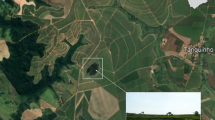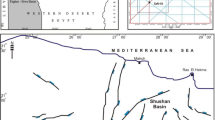Abstract
This study evaluated remedial alternatives for a petroleum-contaminated site where an unconfined aquifer composed of a sandy layer of about 3–3.5 m thickness is covered by alluvial deposits and reclaimed soil of about 1.5 m thickness. Precambrian gneiss, of low permeability, lies below the sandy layer. The shallow water table is about 3 m below the surface, but shows high fluctuations of up to 1.5 m in response to precipitation events. The unsaturated soil near the water table and the groundwater are highly contaminated with petroleum hydrocarbons, especially toluene, which have apparently leaked from storage tanks. Selection of the remedial alternatives required consideration of the relevant laws on soil and groundwater conservation in Korea, the results of risk analysis and the hydrogeological conditions. The contaminated area has been divided into zones in which different remediation goals are set based on risk analysis and the degree of natural attenuation. It is estimated that the clean-up goal can be achieved in two years by the combined use of a trench drain and well point pumping to collect the contaminated groundwater for treatment, and a dual air injection system for the contaminated soil.










Similar content being viewed by others
References
ASTM (1995) Standard guide for risk-based corrective action applied at petroleum release sites. E1739–95, Annual Book of ASTM Standards, Philadelphia
Bedient PB, Rifai HS, Newell CJ (1994) Ground water contamination: transport and remediation. PTR Prentice Hall, Englewood Cliffs
Fountain JC (1998) Technologies for dense nonaqueous phase liquid source zone remediation. TE-98–02, GWRTAC (Ground-Water Remediation Technologies Analysis Center), Pittsburgh
Lee CH (2000) Site assessment and in-situ remediation technology application for contaminated sites. Seoul National University, Seoul, Korea, 198 pp
Lee CH, Lee JY, Cheon JY, Lee KK (2001a) Attenuation of petroleum hydrocarbons in smear zones: a case study. J Environ Eng 127:639–647
Lee JY, Cheon JY, Lee KK, Lee SY, Lee MH (2001b) Statistical evaluation of geochemical parameters distribution in a ground water system contaminated with petroleum hydrocarbons. J Environ Qual 35:1548–1563
Lee JY, Cheon JY, Lee KK, Lee SY, Lee MH (2001c) Factors affecting the distribution of hydrocarbon contaminants and hydrogeochemical parameters in a shallow sand aquifer. J Cont Hydrol 50:139–158
Lee JY, Lee CH, Lee KK, Choi SI (2001d) Soil vapor extraction and bioventing pilot tests in a petroleum contaminated site in Korea. Soil Sediment Cont 10: 439–458
Lee CH, Lee JY, Jang WY, Jeon YH, Lee KK (2002) Evaluation of air injection and extraction tests in a petroleum contaminated site, Korea. Water Air Soil Pollut 135:65–91
Marinelli F, Durnford DS (1996) LNAPL thickness in monitoring wells considering hysteresis and entrapmemt. Ground Water 34:405–414
Sara MN (1994) Standard handbook for solid and hazardous waste facility assessments. Lewis, Boca Raton
USEPA (Environmental Protection Agency) (1988) Guidance on remedial actions for contaminated ground water at Superfund sites. EPA/540/G-99/003, OSWER Directive 9283.1-2, US EPA, Washington, DC
USEPA (Environmental Protection Agency) (1989) Risk assessment guidance for Superfund. EPA/540/1-89/002, OSWER, US EPA, Washington, DC
USEPA (Environmental Protection Agency) (1995) Bioventing principles and practice. EPA/540/R-95/534a, OSWER, US EPA, Washington, DC
USEPA (Environmental Protection Agency) (1997) Design guidelines for conventional pump-and-treat systems. EPA/540/S-97/504, OSWER, US EPA, Washington, DC
Wong JHC, Lim CH, Nolen GL (1997) Design of remediation systems. Lewis, Boca Raton
Zheng C, Bennett GD, Andrews CB (1992) Reply to discussion of analysis of ground-water remedial alternatives at a Superfund site. Ground Water 30:440–442
Author information
Authors and Affiliations
Corresponding author
Rights and permissions
About this article
Cite this article
Lee, J.Y., Lee, C.H. & Lee, K.K. Evaluation of remedial alternatives for a petroleum contaminated unconfined aquifer with fluctuating groundwater level. Env Geol 44, 968–978 (2003). https://doi.org/10.1007/s00254-003-0840-z
Received:
Accepted:
Published:
Issue Date:
DOI: https://doi.org/10.1007/s00254-003-0840-z




